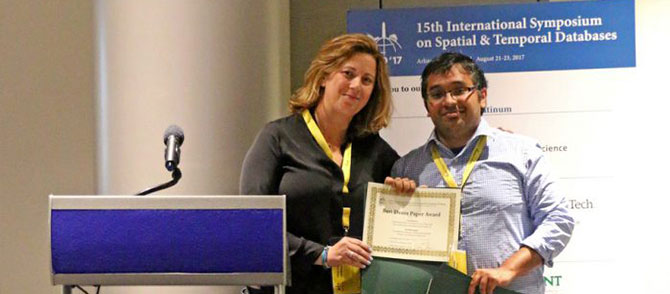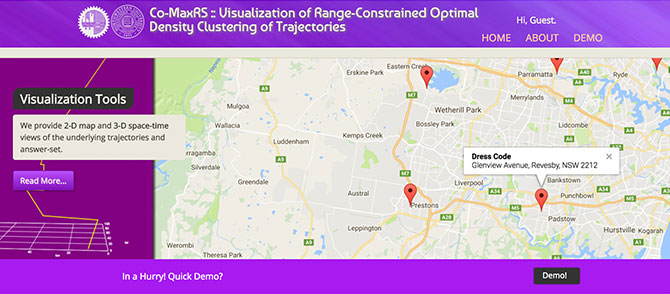Hussain & Trajcevski Win Best Demo Award at SSTD 2017
Their work is entitled: "Visualization of Range-Constrained Optimal Density Clustering of Trajectories."

EECS Graduate Student Mas-ud Hussain (Ph.D. 18') and his Advisor Dr. Goce Trajcevski (Adjunct faculty, EECS; Associate Professor at Iowa State) received the Best Demo Award at the 15th International Symposium on Spatial and Temporal Databases (SSTD 2017) for their work entitled: "Visualization of Range-Constrained Optimal Density Clustering of Trajectories"; co-authored with Kazi Ashik Islam and Mohammed Eunus Ali (Bangladesh University of Engineering and Technology). SSTD 2017 was held in the Washington, D.C. area at the George Mason University campus in Arlington, Virginia, USA, August 21-23.
Their demo presented a system for efficient detection, continuous maintenance and visualization of range-constrained detection and maintenance of optimal density clusters of moving objects trajectories, a.k.a. Continuous Maximizing Range Sum (Co-MaxRS) queries, useful in any domain involving continuous detection of “most interesting” regions involving mobile entities (e.g., traffic monitoring, environmental tracking, etc.). The system solves two important problems: (1) Efficiently computing Co-MaxRS answer-set; and (2) Visualizing the results, and their demo presented the implementation of efficient pruning schemes and compact data structures, along with end-user tools and visualization.
Mas-ud Hussain is currently a 4th year CS Ph.D. student in Department of EECS of McCormick School of Engineering & Applied Sciences, Northwestern University. While working under the supervision of Prof. Goce Trajcevski, and co-advised by Prof. Peter Scheuermann, his primary research interests include: Querying and Mining in Probabilistic Databases; Spatial, Uncertain, and Moving Objects Databases; Data Management in Wireless Sensor Networks; Context-Awareness in Recommendation Systems.

Abstract: We present a system for efficient detection, continuous maintenance and visualization of range-constrained optimal density clusters of moving objects trajectories, a.k.a. Continuous Maximizing Range Sum (Co-MaxRS) queries. Co-MaxRS is useful in any domain involving continuous detection of “most interesting” regions involving mobile entities (e.g., traffic monitoring, environmental tracking, etc.). Traditional MaxRS finds a location of a given rectangle R which maximizes the sum of the weighted-points (objects) in its interior. Since moving objects continuously change their locations, the MaxRS at a particular time instant need not be a solution at another time instant. Our system solves two important problems: (1) Efficiently computing Co-MaxRS answer-set; and (2) Visualizing the results. This demo will present the implementation of our efficient pruning schemes and compact data structures, and illustrate the end-user tools for specifying the parameters and selecting datasets for Co-MaxRS, along with visualization of the optimal locations.
The 2017 International Symposium on Spatial and Temporal Databases (SSTD 2017) is the 15th event of a series of biannual symposia that discuss new and exciting research in spatial, temporal and spatio-temporal data management and related technologies with the goal to set future research directions. SSTD symposia primarily focus on original results in theoretical foundations, design, implementation, and applications of spatial and temporal database technology. SSTD also welcomes experience reports from application specialists and the commercial community that describe lessons learned in the development, operation, and maintenance of actual systems in practical and innovative applications. The goal is to exchange research ideas and results across academia, industry and government from diverse geographies, and career stages.
